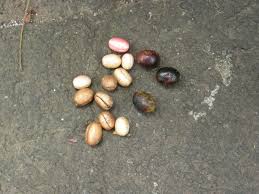http://www.sidhhaherbs.blogspot.com
POLYALTHIA LONGIFOLIA நெட்டிலிங்கம்
Polyalthia longifolia's common names include False Ashoka, the Buddha Tree, Indian mast tree, and Indian Fir tree. Its names in other languages include Ashoka or Devadaru in Sanskrit, Debdaru in Bengali and Hindi, Asopalav (Gujarati), Glodogan tiang (Indonesian), Devdar in marathi and Nettilinkam in Tamil, and araNamaram: അരണമരം (Malayalam). There are two important traditions associated with the tree in India (presumably in its full, untrimmed, form with spreading branches), one being of Sita taking shelter in the shade of Ashoka when in captivity (found in the Ramayana) and another that of the Ashoka tree requiring a kick from a beautiful woman on spring festival day before it would bloom (in the Malavikagnimitra, for example). However, these associations are linked to the real Ashoka tree not the false Ashoka tree (Polyalthia longifolia).Thanks Wiki
இதை தீக்குச்சி மரம் என்பர் பெரியோர். இதனை வைத்தே தீக்குச்சி தயாரிக்கிறார்கள்.
 Polyalthia Longifolia can be grown easily from seed or cuttings. It is a fast growing tree and requires good exposure to sunlight and moderate watering.
Polyalthia Longifolia can be grown easily from seed or cuttings. It is a fast growing tree and requires good exposure to sunlight and moderate watering.
POLYALTHIA LONGIFOLIA நெட்டிலிங்கம்
Polyalthia longifolia's common names include False Ashoka, the Buddha Tree, Indian mast tree, and Indian Fir tree. Its names in other languages include Ashoka or Devadaru in Sanskrit, Debdaru in Bengali and Hindi, Asopalav (Gujarati), Glodogan tiang (Indonesian), Devdar in marathi and Nettilinkam in Tamil, and araNamaram: അരണമരം (Malayalam). There are two important traditions associated with the tree in India (presumably in its full, untrimmed, form with spreading branches), one being of Sita taking shelter in the shade of Ashoka when in captivity (found in the Ramayana) and another that of the Ashoka tree requiring a kick from a beautiful woman on spring festival day before it would bloom (in the Malavikagnimitra, for example). However, these associations are linked to the real Ashoka tree not the false Ashoka tree (Polyalthia longifolia).Thanks Wiki
இதை தீக்குச்சி மரம் என்பர் பெரியோர். இதனை வைத்தே தீக்குச்சி தயாரிக்கிறார்கள்.
| APolyalthia Longifolia var. pendula or The Mast Tree is one of the prime choices of landscape designers. This evergreen, tall and slender tree grows symmetrically and produces fresh and shining green foliage. A Polyalthia Longifolia tree grows as tall as 12 meter. The entire length of the plant is covered by long and wavy leaves. The beautiful contrast of new golden and coppery brown leaves against old dark-green leaves make a spectacular show. |
Polyalthia Longifolia flowers during spring for a brief period (approximately two to three weeks). During this period, the entire tree is covered with small star-shaped flowers of pale green color. The flowers grow in clusters and attract birds and butterflies.
Flowering is followed by egg-shaped fruits that are visited by bats and flying foxes.In spring the tree is covered with delicate star-like pale green flowers. The flowers last for a short period, usually two to three weeks, are not conspicuous due to their color.
Fruit is borne in clusters of 10-20, initially green but turning purple or black when ripe. These are loved by birds such as the Asian Koel Eudynamys scolopaceus and bats including flying foxes.
The leaves are use for ornamental decoration and are used in festivals. The tree is a main attraction in gardens throughout India. The tree can be cut into various shapes and maintained in required sizes. In past, the flexible, straight and light-weight trunks were used in the making of masts for sailing ships. That is why the tree is also known as the Mast Tree. Today, the tree is mostly used for manufacturing small articles such as pencil boxes etc.
Methanolic extracts of Polyalthia longifolia have yielded 20 known and two new organic compounds, some of which show cytotoxic properties.[1]
Polyalthia Longifolia can be easily trimmed in to a straight columnar growth covered with a lot of leaves. For this reason, it is suitable for landscapes, as a hedge tree, and as visual dividers or wind blockers in open spaces.
The trunk of Polyalthia Longifolia has grey bark. Both the trunk and the bark are used in manufacturing of fiber. Timber is used for making boxes, pencils and long masts – that is why it is also known as the mast tree. In India and Sri Lanka, where the mast tree is held in high esteem, its leaves are used in religious ceremonies and for decorating arches and doorways.
Sometimes, Polyalthia Longifolia, is incorrectly identified as Ashoka tree (Saraca Indica) because of closely resembling leaves of both species. Other names of the mast tree are Asupala or the Buddha tree.
Polyalthia Longifolio or the Mast Tree belongs to the Annonaceae family, which is one of the largest families of flowering plants and usually known as the custard apple family
.இதனை முன்பின் பார்த்திருக்கிறீர்களா?
http://www.sidhhaherbs.blogspot.com
.இதனை முன்பின் பார்த்திருக்கிறீர்களா?
http://www.sidhhaherbs.blogspot.com
No comments:
Post a Comment